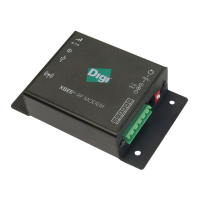XBee® Wi-Fi RF Modules
© 2013 Digi International, Inc. 19
Power Supply
Poor power supply can lead to poor radio performance, especially if the supply voltage
is not kept within tolerance or is excessively noisy. To help reduce noise, a 1µF and
8.2pF capacitor are recommended to be placed as near to pin 1 on the PCB as possible.
If using a switching regulator for your power supply, switching frequencies above 500
kHz are preferred. Power supply ripple should be limited to a maximum 50mV peak to
peak.
Recommended Pin Connections
The only required pin connections are VCC, GND, and either DOUT and DIN or SPI_CLK,
SPI_nSSEL, SPI_MOSI, and SPI MISO. To support serial firmware updates, VCC, GND,
DOUT, DIN, nRTS, and nDTR should be connected.
All unused pins should be left disconnected. All inputs on the radio can be pulled high
with 40k internal pull-up resistors using the PR software command. No specific
treatment is needed for unused outputs.
For applications that need to ensure the lowest sleep current, inputs should never be
left floating. Use internal or external pull-up or pull-down resistors, or set the unused
I/O lines to outputs. The deep sleep (pin sleep) current specification can be achieved
using a standard XBee Interface Board with the XBee Wi-Fi module's pull-up and pull-
down resistors configured as default.
Other pins may be connected to external circuitry for convenience of operation. For
example, the Associate signal (through-hole pin 15 / surface mount pin 28) and the
On_nSLEEP signal (through-hole pin 13 / surface mount pin 26) will change level or
behavior based on the state of the module.
Board Layout
When designing the host PCB, be sure to account for the module dimensions as shown
in the mechanical drawings section. See the Manufacturing Information chapter for
recommended footprints and required keepout areas. Use good design practices when
connecting Power and Ground, making those traces wide enough to comfortably
support the maximum currents or using planes if possible.
In addition to mechanical considerations, care should be taken in the choice of antenna
and antenna location. Most antennas radiate perpendicular to the direction they point.
Thus, a vertical antenna emits across the horizon. Metal objects near internal or
external antennas may cause reflections and reduce the antenna’s ability to radiate
efficiently. Antennas should reside above or away from any metal objects, including
batteries, tall electrolytic capacitors or metal enclosures. If using a metal enclosure, the
antenna should be located externally (using an integral antenna in a metal enclosure will
greatly reduce the range). Range may also be affected by metal objects between
transmitting and receiving antennas. Some objects that are often overlooked are metal
poles, metal studs or beams in structures, concrete (it is usually reinforced with metal

